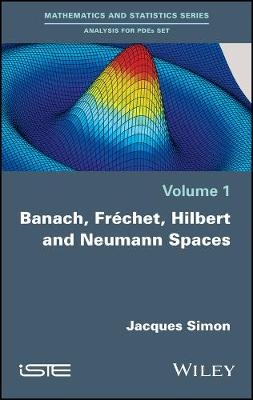
Banach, Fréchet, Hilbert and Neumann Spaces
ISTE Ltd and John Wiley & Sons Inc (Verlag)
9781786300096 (ISBN)
This book is the first of a set dedicated to the mathematical tools used in partial differential equations derived from physics.
Its focus is on normed or semi-normed vector spaces, including the spaces of Banach, Fréchet and Hilbert, with new developments on Neumann spaces, but also on extractable spaces.
The author presents the main properties of these spaces, which are useful for the construction of Lebesgue and Sobolev distributions with real or vector values and for solving partial differential equations. Differential calculus is also extended to semi-normed spaces.
Simple methods, semi-norms, sequential properties and others are discussed, making these tools accessible to the greatest number of students – doctoral students, postgraduate students – engineers and researchers without restricting or generalizing the results.
Jacques Simon, CNRS, France.
Introduction xi
Familiarization with Semi-normed Spaces xv
Notations xvii
Chapter 1 Prerequisites 1
1.1 Sets, mappings, orders 1
1.2 Countability 3
1.3 Construction of R 4
1.4 Properties of R 5
Part 1 Semi-normed Spaces 9
Chapter 2 Semi-normed Spaces 11
2.1 Definition of semi-normed spaces 11
2.2 Convergent sequences 15
2.3 Bounded, open and closed sets 17
2.4 Interior, closure, balls and semi-balls 21
2.5 Density, separability 23
2.6 Compact sets 25
2.7 Connected and convex sets 30
Chapter 3 Comparison of Semi-normed Spaces 33
3.1 Equivalent families of semi-norms 33
3.2 Topological equalities and inclusions 34
3.3 Topological subspaces 39
3.4 Filtering families of semi-norms 43
3.5 Sums of sets 46
Chapter 4 Banach, Fréchet and Neumann Spaces 49
4.1 Metrizable spaces 49
4.2 Properties of sets in metrizable spaces 51
4.3 Banach, Fréchet and Neumann spaces 55
4.4 Compacts sets in Fréchet spaces 57
4.5 Properties of R 58
4.6 Convergent sequences 60
4.7 Sequential completion of a semi-normed space 62
Chapter 5 Hilbert Spaces 65
5.1 Hilbert spaces 65
5.2 Projection in a Hilbert space 68
5.3 The space Rd 70
Chapter 6 Product, Intersection, Sum and Quotient of Spaces 73
6.1 Product of semi-normed spaces 73
6.2 Product of a semi-normed space by itself 78
6.3 Intersection of semi-normed spaces 80
6.4 Sum of semi-normed spaces 83
6.5 Direct sum of semi-normed spaces 89
6.6 Quotient space 93
Part 2 Continuous Mappings 95
Chapter 7 Continuous Mappings 97
7.1 Continuous mappings 97
7.2 Continuity and change of topology or restriction 100
7.3 Continuity of composite mappings 102
7.4 Continuous semi-norms 102
7.5 Continuous linear mappings 104
7.6 Continuous multilinear mappings 107
7.7 Some continuous mappings 111
Chapter 8 Images of Sets Under Continuous Mappings 115
8.1 Images of open and closed sets 115
8.2 Images of dense, separable and connected sets 117
8.3 Images of compact sets 119
8.4 Images under continuous linear mappings 121
8.5 Continuous mappings in compact sets 123
8.6 Continuous real mappings 124
8.7 Compacting mappings 125
Chapter 9 Properties of Mappings in Metrizable Spaces 129
9.1 Continuous mappings in metrizable spaces 129
9.2 Banach’s fixed point theorem 133
9.3 Baire’s theorem 134
9.4 Open mapping theorem 136
9.5 Banach–Schauder’s continuity theorem 138
9.6 Closed graph theorem 139
Chapter 10 Extension of Mappings, Equicontinuity 141
10.1 Extension of equalities by continuity 141
10.2 Continuous extension of mappings 142
10.3 Equicontinuous families of mappings 146
10.4 Banach–Steinhaus equicontinuity theorem 148
Chapter 11 Compactness in Mapping Spaces 153
11.1 The spaces F(X; F) and C(X; F)-pt 153
11.2 Zorn’s lemma 154
11.3 Compactness in F(X; F) 157
11.4 An Ascoli compactness theorem in C(X; F)-pt 161
Chapter 12 Spaces of Linear or Multilinear Mappings 163
12.1 The space L(E; F) 163
12.2 Bounded sets in L(E; F) 165
12.3 Sequential completeness of L(E; F) when E is metrizable 167
12.4 Semi-norms and norm on L(E; F) when E isnormed 169
12.5 Continuity of the composition of linear mappings 171
12.6 Inversibility in the neighborhood of an isomorphism 174
12.7 The space Ld(E1 × ··· × Ed; F) 178
12.8 Separation of the variables of a multilinear mapping 181
Part 3 Weak Topologies 187
Chapter 13 Duality 189
13.1 Dual 189
13.2 Dual of a metrizable or normed space 193
13.3 Dual of a Hilbert space 196
13.4 Extraction of ∗ weakly converging subsequences 199
13.5 Continuity of the bilinear form of duality 203
13.6 Dual of a product 205
13.7 Dual of a direct sum 206
Chapter 14 Dual of a Subspace 209
14.1 Hahn–Banach theorem 209
14.2 Corollaries of the Hahn–Banach theorem 211
14.3 Characterization of a dense subspace 212
14.4 Dual of a subspace 213
14.5 Dual of an intersection 215
14.6 Dangerous identifications 216
Chapter 15 Weak Topology 221
15.1 Weak topology 221
15.2 Weak continuity and topological inclusions 224
15.3 Weak topology of a product 225
15.4 Weak topology of an intersection 226
15.5 Norm and semi-norms of a weak limit 228
Chapter 16 Properties of Sets for the Weak Topology 231
16.1 Banach–Mackey theorem (weakly bounded sets) 231
16.2 Gauge of a convex open set 233
16.3 Mazur’s theorem (weakly closed convex sets) 235
16.4 ¢Smulian’s theorem (weakly compact sets) 237
16.5 Semi-weak continuity of a bilinear mapping 240
Chapter 17 Reflexivity 243
17.1 Reflexive spaces 243
17.2 Sequential completion of a semi-reflexive space 247
17.3 Prereflexivity of metrizable spaces 248
17.4 Reflexivity of Hilbert spaces 250
17.5 Reflexivity of uniformly convex Banach spaces 252
17.6 A property of the combinations of linear forms 256
17.7 Characterizations of semi-reflexivity 257
17.8 Reflexivity of a subspace 261
17.9 Reflexivity of the image of a space 261
17.10 Reflexivity of the dual 263
Chapter 18 Extractable Spaces 265
18.1 Extractable spaces 265
18.2 Extractability of Hilbert spaces 266
18.3 Extractability of semi-reflexive spaces 267
18.4 Extractability of a subspace or of the image of a space 269
18.5 Extractability of a product or of a sum of spaces 270
18.6 Extractability of an intersection of spaces 271
18.7 Sequential completion of extractable spaces 271
Part 4 Differential Calculus 273
Chapter 19 Differentiable Mappings 275
19.1 Differentiable mappings 275
19.2 Differentiality, continuity and linearity 277
19.3 Differentiation and change of topology or restriction 279
19.4 Mean value theorem 281
19.5 Bounds on a real differentiable mapping 284
19.6 Differentiation of a composite mapping 286
19.7 Differential of an inverse mapping 289
19.8 Inverse mapping theorem 290
Chapter 20 Differentiation of Multivariable Mappings 295
20.1 Partial differentiation 295
20.2 Differentiation of a multilinear or multi-component mapping 298
20.3 Differentiation of a composite multilinear mapping 300
Chapter 21 Successive Differentiations 303
21.1 Successive differentiations 303
21.2 Schwarz’s symmetry principle 305
21.3 Successive differentiations of a composite mapping 308
Chapter 22 Derivation of Functions of One Real Variable 313
22.1 Derivative of a function of one real variable 313
22.2 Derivative of a real function of one real variable 315
22.3 Leibniz formula 319
22.4 Derivatives of the power, logarithm and exponential functions 320
Bibliography 325
Cited Authors 331
Index 335
| Erscheinungsdatum | 26.05.2017 |
|---|---|
| Verlagsort | London |
| Sprache | englisch |
| Maße | 163 x 239 mm |
| Gewicht | 680 g |
| Themenwelt | Mathematik / Informatik ► Mathematik ► Analysis |
| Mathematik / Informatik ► Mathematik ► Angewandte Mathematik | |
| ISBN-13 | 9781786300096 / 9781786300096 |
| Zustand | Neuware |
| Informationen gemäß Produktsicherheitsverordnung (GPSR) | |
| Haben Sie eine Frage zum Produkt? |
aus dem Bereich


